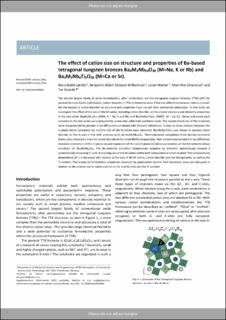| dc.contributor.author | Løndal, Nora Statle | |
| dc.contributor.author | Williamson, Benjamin Albert Dobson | |
| dc.contributor.author | Walker, Julian Bradley | |
| dc.contributor.author | Einarsrud, Mari-Ann | |
| dc.contributor.author | Grande, Tor | |
| dc.date.accessioned | 2024-04-10T06:32:42Z | |
| dc.date.available | 2024-04-10T06:32:42Z | |
| dc.date.created | 2024-01-08T16:11:28Z | |
| dc.date.issued | 2024 | |
| dc.identifier.issn | 1463-9076 | |
| dc.identifier.uri | https://hdl.handle.net/11250/3125633 | |
| dc.description.abstract | The second largest family of oxide ferroelectrics, after perovskites, are the tetragonal tungsten bronzes (TTB) with the general formula A24A12C4B12B28O30. Cation disorder in TTBs is known to occur if the size difference between cations is small, but the impact of cation disorder on structure and properties has not yet been extensively addressed. In this study we investigate the effect of the size of the M cation, including cation disorder, on the crystal structure and dielectric properties in the two series Ba4M2Nb10O30 (BMN, A = Na, K and Rb) and Ba4M2Nb8Ti2O30 (BMNT, M = Ca, Sr). Dense and phase pure ceramics in the two series were prepared by a two-step solid state synthesis route. The crystal structures of the materials were characterized by powder X-ray diffraction combined with Rietveld refinement. A close to linear relation between the in-plane lattice parameter (a) and the size of the M-cation were observed. Ba4M2Nb8Ti2O30 was shown to possess cation disorder on the A-sites in line with previous work on Ba4M2Nb10O30. Thermodynamic calculations from density functional theory also indicated a drive for cation disorder in the three BMN compositions. Non-ambient temperature X-ray diffraction revealed contraction of the in-plane (a) and expansion of the out-of-plane (c) lattice parameters at the ferroelectric phase transition for Ba4M2Nb10O30. The ferroelectric transition temperature acquired by dielectric spectroscopy showed a systematically increasing TC with decreasing size of the M-cation within both compositional series studied. The compositional dependence of TC is discussed with respect to the size of the M-cation, cation disorder and the tetragonality, as well as the Ti-content. The relaxor to ferroelectric properties observed by polarization–electric field hysteresis loops are discussed in relation to the relative size of cations on the on A1 and A2 sites and the Ti-content. | en_US |
| dc.language.iso | eng | en_US |
| dc.publisher | Royal Society of Chemistry | en_US |
| dc.rights | Navngivelse 4.0 Internasjonal | * |
| dc.rights.uri | http://creativecommons.org/licenses/by/4.0/deed.no | * |
| dc.title | The effect of cation size on structure and properties of Ba-based tetragonal tungsten bronzes Ba4M2Nb10O30 (M = Na, K or Rb) and Ba4M2Nb8Ti2O30 (M = Ca or Sr)† | en_US |
| dc.title.alternative | The effect of cation size on structure and properties of Ba-based tetragonal tungsten bronzes Ba<inf>4</inf>M<inf>2</inf>Nb<inf>10</inf>O<inf>30</inf> (M = Na, K or Rb) and Ba<inf>4</inf>M<inf>2</inf>Nb<inf>8</inf>Ti<inf>2</inf>O<inf>30</inf> (M = Ca or Sr) | en_US |
| dc.type | Peer reviewed | en_US |
| dc.type | Journal article | en_US |
| dc.description.version | acceptedVersion | en_US |
| dc.source.journal | Physical Chemistry, Chemical Physics - PCCP | en_US |
| dc.source.issue | 4 | en_US |
| dc.identifier.doi | 10.1039/d3cp05666j | |
| dc.identifier.cristin | 2222601 | |
| cristin.ispublished | true | |
| cristin.qualitycode | 2 | |

